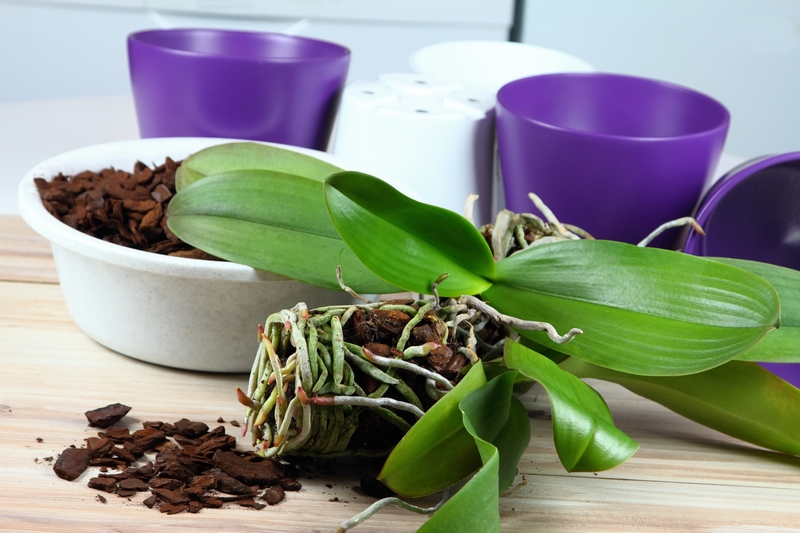Weather-Ready Gardens: A Guide to Preventing Damage
Posted on 27/09/2025
Weather-Ready Gardens: A Guide to Preventing Damage
Gardens are places of beauty, relaxation, and sustenance. However, they are also highly vulnerable to the unpredictable forces of nature. Extreme weather, from scorching heat waves to torrential rains, high winds, frost, and even drought, can cause significant harm to plants and landscapes. With climate patterns changing and weather extremes becoming more frequent, it's more important than ever to prepare your garden for any environmental challenges. In this comprehensive guide, you'll discover practical strategies for weather-proofing your garden and preventing weather damage to your beloved outdoor space.
Why Preparing for Weather Matters in Gardening
Creating a weather-ready garden isn't just about protecting the plants; it's also about safeguarding your investment, time, and effort. When your garden is resilient, you can enjoy lush greenery and bountiful harvests, while minimizing losses from storms, droughts, frosts, or heatwaves. Being proactive ensures your garden can withstand whatever Mother Nature throws its way.
Key Risks from Unpredictable Weather
- Flooding and Excess Water: Causes root rot and washes away soil nutrients.
- High Winds: Uproots plants, snaps stems, and damages structures.
- Frost and Sudden Temperature Drops: Kills sensitive plants, disrupts blooming, and stunts growth.
- Heatwaves: Dehydrates soil, wilts plants, and stresses delicate species.
- Drought: Leads to stunted growth and increased pest issues.
By understanding these weather-related threats, gardeners can create plans for a truly weather-resistant garden.

Planning & Designing a Weather-Resilient Garden
Building a weather-proof garden starts before you even put a seed in the ground. Smart design and careful planning will lay a strong foundation for future resilience.
Choose the Right Plant Species
- Native Plants: These are adapted to your local climate and weather extremes.
- Drought-Resistant Plants: Great for areas prone to low rainfall and heatwaves.
- Flood-Tolerant Species: Ideal for gardens with poor drainage or heavy rains.
- Sturdy Trees and Shrubs: Help windproof your garden and offer protection to smaller plants.
*Tip:* Always research plant hardiness zones and pick species suited to your area's common weather patterns. Zones 3-10 in the United States each have their own plant recommendations for maximum weather resilience.
Microclimates: Make the Most of Your Garden's Unique Spots
Every garden contains mini zones that behave differently in weather. Areas by fences or walls often stay warmer, while lower points may be frost pockets or flood-prone. Understanding your garden's microclimates helps you choose ideal plant placements for optimal health and protection.
- South-facing areas: Receive more sun (heat-tolerant plants thrive).
- Low-lying spots: May collect water; use for moisture-loving species.
- Sheltered corners: Protect delicate plants from wind and frost.
Essential Strategies to Prevent Weather Damage
Even the best-laid plans face tough conditions. Smart gardeners adopt a set of weather protection measures to enhance garden longevity and performance.
Soil Health: Your First Line of Defense
Healthy soil acts like a buffer, helping plants survive both drought and flood. Here's how to build robust soil:
- Add Organic Matter: Compost and well-rotted manure improve drainage and water retention.
- Mulch Regularly: Mulching keeps roots cool during heatwaves, conserves moisture, and insulates against frost.
- Test Soil Structure: Amend clay with sand or organic material for better drainage; add compost to sandy soil for improved water retention.
Water Management Techniques
- Install Rain Barrels: Collect runoff to provide water during dry spells.
- Drip Irrigation: Delivers water slowly at the root, minimizing waste and plant stress in droughts.
- Swales & French Drains: Redirect excess rainwater and prevent flooding or erosion.
*Best Practice*: Water early in the morning or late evening to prevent evaporation and encourage deep root growth.
Wind Protection & Structural Support
Wind can topple plants, damage crops, and dry out soil. Mitigate its effects with these methods:
- Windbreaks: Plant dense hedges (like privet or boxwood), rows of trees, or install lattice fencing to block damaging gusts.
- Staking & Caging: Use stakes, cages, or supports for young or top-heavy plants to prevent snapping.
- Temporary Barriers: Set up shade cloths or horticultural fleece when severe weather is forecast.
Protection from Frost & Temperature Extremes
- Frost Cloths & Row Covers: Drape these over tender plants when frost threatens.
- Cold Frames & Cloches: Provide warmth for seedlings or out-of-season vegetables.
- Mulching: Heavy mulch acts as an insulating blanket for perennial roots.
- Water Before a Freeze: Moist soil retains more heat than dry soil, offering vital protection.
Weather-Responsive Maintenance Practices
Regular garden care can greatly improve resilience and prevent weather-induced plant damage. Adopting specific maintenance habits will ensure your garden weathers every storm.
Routine Inspections
- Check for Signs of Stress: Wilting, yellowing, or leaf scorch may signal underlying problems.
- Prune Damaged Limbs: Remove broken branches quickly to prevent disease and pests.
- Monitor Soil Moisture: Use a moisture meter or dig test to avoid over- or under-watering.
Adjusting Care According to the Forecast
- Before a Heatwave: Water deeply, mulch generously, and provide temporary shade.
- Before Heavy Rain: Clear drains and gutters, check for pooling spots, and support tall plants.
- Before Frost: Move potted plants indoors or to shelter, and cover exposed beds with fleece.
Pest and Disease Vigilance During Stress
- Look for Fungal Growth: Wet weather and poor drainage promote disease.
- Watch for Insects: Heat and drought can increase pest outbreaks.
- Promote Beneficial Insects: Attract ladybugs, lacewings, and other helpful species to keep pests in check.
Harnessing Technology for Weather-Resistant Gardening
Modern gardeners can take advantage of technology to make their gardens more resilient than ever before.
- Weather Apps & Alerts: Stay updated on upcoming events, such as frost warnings or heat advisories.
- Automated Irrigation Systems: Water your garden at optimal times without manual labor, saving time and ensuring adequate hydration during droughts.
- Soil Sensors: Provide readings on moisture, temperature, and nutrients, allowing for swift interventions before plants suffer.
- Smart Greenhouses: Automate vents, heating, or shading based on real-time weather data.
Repairing Weather Damage and Encouraging Recovery
Despite all the preparation, some weather damage in gardens may be unavoidable. Quick action can limit long-term losses.
Post-Storm Assessment
- Survey for Broken Branches & Uprooted Plants: Remove hazards and reset any recoverable specimens.
- Check for Soil Erosion: Refill beds, replace lost mulch, and stabilize with groundcovers.
- Watch for Wilt: Damaged roots may need extra watering and nutrients.
Pruning and Plant Replacement
- Cut Back Before Regrowth: Remove storm-damaged or frost-burnt areas before new shoots appear.
- Replace Non-Recoverable Species: Choose hardier replacements suited to your climate trends.
Soil Restoration
- Replenish Nutrients: Apply compost and balanced fertilizer after floods or heavy rain to restore fertility.
- Improve Structure: Use organic material to regain texture and drainage lost to compaction.

Building Long-Term Resilience in Weather-Ready Gardens
Gardening is an ongoing partnership with the environment. Fostering a weather-resilient garden means building adaptable habits and landscape flexibility.
- Keep Records: Note what works--and what fails--after each major weather event for future decisions.
- Rotate Crops and Plantings: This reduces disease risk and keeps the garden robust under changing conditions.
- Diversify Species: A varied garden will avoid total loss if one type is affected by specific weather.
- Plan for Native Wildlife: Birds and insects help manage pests and pollinate, improving overall garden health.
Regular learning and adaptation are key to thriving gardens in a changing climate.
Conclusion: Embrace the Elements, Protect Your Plants
Creating a truly weather-ready garden isn't about eliminating all risks--rather, it's about embracing nature's unpredictability with thoughtful planning and responsive care. By selecting the right plants, employing practical protective strategies, using the latest technologies, and learning from each season, your resilient garden can not only survive, but truly flourish in any weather.
Remember: a little preparation today leads to a thriving, beautiful, and damage-resistant garden tomorrow.
- Assess and adapt regularly
- Emphasize soil health
- Invest in smart protection and infrastructure
- Blend tradition with technology
Bookmark this comprehensive guide to preventing weather damage in your garden and revisit it with every change of the season. Your vigilant, weather-wise approach will reap lush rewards for years to come.

